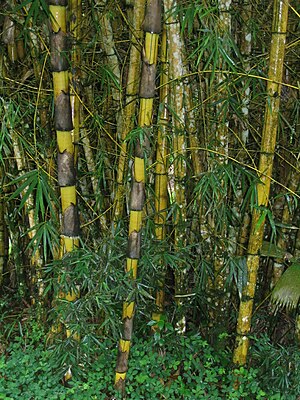 Image via Wikipedia
Image via Wikipedia
Bamboo is already used to provide food, housing and income to over 2.2 billion people worldwide. This is just the beginning. It can bring these same
benefits to Africa and The Biomass Corporation intends to be a leader in this regard.
As the world realizes that the days of cheap, abundant fossil fuels have in all likelihood come to an end and that the use of such fuels are having a major negative impact on our climate, the need for alternatives has become obvious.
Giant timber bamboo sequesters more carbon dioxide than any other plant. It is relatively easy to grow and maintain once planted, and many of its species are well adapted to the African climate.
A viable replacement for wood. Bamboo is one of the
strongest building materials. Bamboo’s tensile strength
is 28,000 per square inch versus 21,000 for steel.
A renewable resource for agro forestry purposes, bamboo is a high-yielding, renewable natural resource. ‘Ply bamboo’ (plywood bamboo) is now being used for wall paneling and bamboo flooring. Bamboo pulp is used for paper making and bamboo charcoal briquettes are used for a traditional-type fuel. It is also widely used as a raw material for housing construction and even as rebar for reinforced concrete beams. But the above are just the ‘traditional’ uses of bamboo.
With modern technological advances, bamboo is an ideal resource to use as the raw biomass for replacing fossil fuels. As the latest technologies evolve to make ‘clean coal’ and bio-fuels (ethanol, etc.), bamboo is the ideal high-yielding biomass. In terms of tonnage per acre or hectare, nothing out yields bamboo. However, it is a cellulosic feedstock and thus ideal for the second-generation technologies that will obviate the need to use food resources for fuel making purposes. It will also allow more fertile land to be devoted to crop purposes and can mitigate the need to replace natural forests.
Bamboo is proven to be a critical element in the balance of oxygen and carbon dioxide in the atmosphere.
Bamboos are excellent for rejuvenating degraded lands and protecting against soil erosion. Plantation
establishment requires minimal capital investment and
builds upon the inherent plant-cultivation skills of local
farmers and foresters.
Bamboos can be harvested annually and non-
destructively.
Bamboos may easily be intercropped with shallow-rooted crops whilst in the developing stage.
As well as the culms, all other parts of the bamboo plant can be used in rural livelihoods – shoots for food, leaves for fodder, and many other cottage industries
Unlike any hardwood or softwood forests, bamboo
forests are not as susceptible to the threat of fires.
Bamboo shoots provide nutrition for millions of people
worldwide.
Bamboos grow more rapidly than trees and start to yield within three to four years of planting.
One can see Giant Bamboo grow – 30 metres in 105
days. Achieves maximum density in 280 days.











